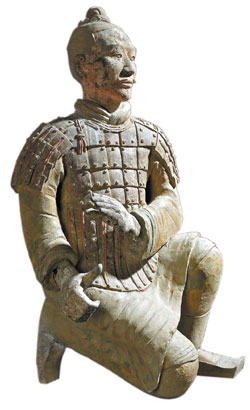China's terracotta warriors are about to pay their visit abroad. They will be heavily guarded throughout their trip and received at a swank venue in London when they arrive on Monday. The 15 figures of different ranks, together with their carts and horses, will appear at one of the biggest public events about China prior to the 2008 Olympics. The warriors are expected to attract 400,000 fans from around the globe.
These representatives from the mausoleum of Emperor Qin Shihuang (259-210 BC) will be part of an exhibition at the British Museum, titled The First Emperor: China's Terracotta Army. The exhibition will open on September 13 and runs for seven months.
"We present the terracotta warriors because they are highly recognizable," says Hannah Boulton, spokeswoman of the British Museum. "People know a lot about them, and will be very interested."
"When people come for the terracotta warriors, they will get to learn more - about the First Emperor's life, the unification of his country and his military prowess, and the myths and mysteries associated with him, and they will have a chance to understand China's past, its present and possible futures," she says.
The terracotta warriors are not the only highlights of the exhibition. Altogether, 120 objects will be displayed, and they are the best finds from the Mausoleum of Qin Shihuang, a tomb complex which is "unparalleled in terms of its extent and magnificence", says Jane Portal, the exhibition curator at the British Museum.
They are on loan from the Qin Shihuang Terracotta Warriors and Horses Museum in Xi'an, capital of Northwest China's Shaanxi Province and also from the provincial cultural heritage administration. "This is the first time that we have sent so many rare relics overseas," says Wu Yongqi, curator of the museum in Xi'an.
Wu says that his museum sent musician figures, dancer figures, acrobat figures, weapons, bronze rituals, and jade and pottery artifacts, as well as the terracotta warriors and their carts and horses. "Our goal is to give the audience in London an all-round view of life in the early part of Chinese history."
Recent finds from the mausoleum will be displayed at the exhibition, says Boulton. These objects, many of which have never been exhibited before, prove that the First Emperor was as concerned with his civilian administration after death as with military matters.
Excavation has been ongoing at the archaeological site about 12 kilometers east of Xi'an, since it was discovered by chance by villagers in 1974. Some of the finds have never been made known: In 1999, 11 terracotta acrobats and strong men were unearthed, and historians decided that they were there to entertain the Emperor in his afterlife.
In October 2000, terracotta civil officials were found, and a year later a pit was discovered which was filled with life-size bronze geese, swans and cranes. Some of the birds will arrive in London together with the terracotta acrobats.
Until now these objects have been packed into boxes. They will be guarded by armed police when they travel to the airport in Xi'an, says Tian Jing, director of the museum's general office.
"The warrior figures are fragile indeed," says Tian. "Many had fallen into parts and even pieces by the time they were unearthed, and it took our conservationists several decades to restore them."
To prevent the relics from being damaged on the way, special measures have been taken to relieve the impact of shakings and the vehicles carrying them will all drive at a speed of less than 60 kilometers per hour, he says.
When they arrive in London, the objects will be installed by professionals, says Boulton from the British Museum.
They will be housed in a venue that lies at the heart of the museum, and designers have worked to create a space that will "capture the power and drama of the objects on display," she says.
The exhibition will examine the First Emperor's life, his achievement in unifying country, the innovations he introduced and the monuments he constructed. It will also look at his quest for eternal life, how he prepared to rule the universe in death from his tomb.
It also reveals that while we have a great deal of information from the surrounding excavations, the tomb mound of the emperor himself is still sealed and could contain even greater treasures.
The First Emperor will be presented as a controversial figure at the exhibition, says Boulton. Being a crucial figure in China's long history, he created what is now known as China - the oldest surviving political entity in the world.
A bronze crane unearthed from the Mausoleum of Qin Shihuang will be displayed in London.
Courtesy of the British Museum
He also began the construction of the Great Wall, and presided over the standardization of currency and script, which represented a huge step toward the development of China as a nation. On the other hand he presided over much forced labor to have his mausoleum built and the Wall constructed.
The target of many assassination attempts, the emperor became obsessed with eternal life, however he died suddenly in 210 BC.
Throughout history, his mysterious life has been a much-debated topic among intellectuals. But the archaeological finds prove his existence and his hand in a few of the nation's greatest landmarks.
"These artifacts are very important," says Portal. "They have indeed ensured that he lives forever, although perhaps not quite as he had originally planned."
Sponsored by Morgan Stanley, the exhibition will be a wonderful chance to see these artifacts close up, and also to "learn about an empire which at its height was the rival of Rome and was to prove historically more enduring," says Portal.
(China Daily August 10, 2007)





